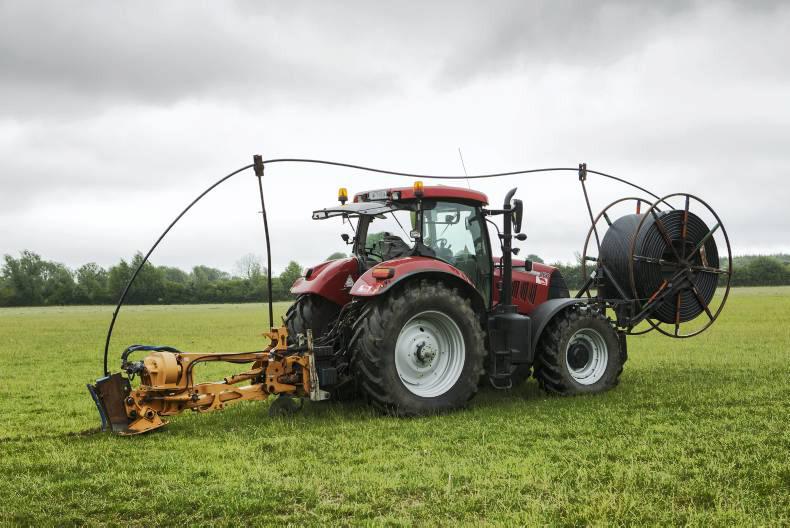Research shows that it takes 6.4 litres of water to produce one litre of milk. With this in mind, farmers hoping to expand are looking at ways of improving and implementing better water systems. Laying larger pipes to increase flow rate and water availability is one of the simpler ways being looked at.
A number of contractors throughout the country are laying these pipes with the use of a mole plough.
This involves cutting a small, narrow slit through the soil into which a water pipe is easily inserted, usually automatically.
John Hanrahan from Hanrahan’s Agri-Services in Tipperary is one such contractor. The Irish Farmers Journal paid a visit to a site where he was undertaking a mole plough job.
John uses a mole plough combined with a water pipe reel to lay different sizes of water pipes for farmers. He also does all the associated fitting to new or existing water troughs.
Picture 1
Here we see the whole pipe-laying unit, which is attached to a 200hp Case tractor. However, John explains that weight is more important than power when it comes to mole ploughing.
For this reason, the unit weighs in excess of 11.5t, which aids traction. The drum on the front of the tractor is capable of holding 3,000 metres of 32mm pipe, 2,000 metres of 40mm pipe or 1,300 metres of 50mm pipe, which unwinds as the tractor moves. Having the drum mounted on the front of the tractor ensures no stress on the pipe, which goes over the cab and down the chute at the back of the blade.
Pictures 2 and 3
The whole system works on vibration. The plough has a box on the back with two shafts that are off-balance inside. These rotate, which causes the vibration. When the plough vibrates, it loosens the ground and helps keep the plough in the ground to a depth of 2ft.
The plough is capable of moving stone and tree roots out of its way to a certain degree, but when it meets solid rock, the plough will ride along on top of it. In picture three, we clearly see how the pipe makes its way down the back of the tractor and out the back of the plough into the ground.
Pictures 4 and 5
John says that it is all electro fusion connections used by Hanrahan’s Agri-Service for the likes of T-joints for troughs and joining pipes.
In picture four, we see how a mobile generator is attached to one of the fittings. These fittings contain an element which melts once heat is applied. This then bonds the joint and the pipe together.
John kindly cut open an electro-fused joint in picture five to show us exactly how the finished joint looks when sealed.
Pictures 6 and 7
On this particular farm, the ground was of excellent quality, which gave a very tidy finish after the plough work. If this was stoney ground, the finish wouldn’t be as clean, as sods would get turned up, disturbing the surface more. The cut usually only takes a quick run over with the tyre of the tractor to finish off the job, as seen in picture seven.
Picture 8
For added convenience, the mole plough can be offset to run alongside passages or ditches. This allows for minimum disturbance to the soil in the middle of paddocks. Having the tractor driving along a passage or roadway will also minimise traction damage even further.
Cost
The purchase and laying of the 32mm pipe in the ground costs the farmer €2 per metre plus VAT, while this increases to €2.20 for 40mm pipe and €2.90 for 50mm pipe.
One of the electro-fusioned T-joints costs in the region of €25 for a one-inch fitting.
Hanrahan’s can also undertake all the associated fitting to new or existing water troughs.












SHARING OPTIONS